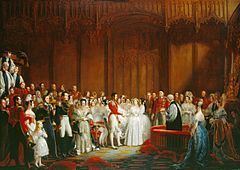Date 10 February 1840 | Location Chapel Royal | |
 | ||
Participants Queen Victoria, Albert, Prince Consort | ||
The wedding of Queen Victoria and Prince Albert of Saxe-Coburg and Gotha (later Prince Consort) took place on 10 February, 1840 at Chapel Royal, St. James's Palace, in London.
Contents
Marriage
Though queen, as an unmarried young woman Victoria was required by social convention to live with her mother, despite their differences over the Kensington System and her mother's continued reliance on Conroy. Her mother was consigned to a remote apartment in Buckingham Palace, and Victoria often refused to meet her. When Victoria complained to Melbourne that her mother's close proximity promised "torment for many years", Melbourne sympathised but said it could be avoided by marriage, which Victoria called a "schocking [sic] alternative". She showed interest in Albert's education for the future role he would have to play as her husband, but she resisted attempts to rush her into wedlock.
Victoria continued to praise Albert following his second visit in October 1839. Albert and Victoria felt mutual affection and the Queen proposed to him on 15 October 1839, just five days after he had arrived at Windsor. They were married on 10 February 1840, in the Chapel Royal of St. James's Palace, London. Victoria was besotted. She spent the evening after their wedding lying down with a headache, but wrote ecstatically in her diary:
I NEVER, NEVER spent such an evening!!! MY DEAREST DEAREST DEAR Albert ... his excessive love & affection gave me feelings of heavenly love & happiness I never could have hoped to have felt before! He clasped me in his arms, & we kissed each other again & again! His beauty, his sweetness & gentleness—really how can I ever be thankful enough to have such a Husband! ... to be called by names of tenderness, I have never yet heard used to me before—was bliss beyond belief! Oh! This was the happiest day of my life!
Albert became an important political adviser as well as the Queen's companion, replacing Lord Melbourne as the dominant, influential figure in the first half of her life. Victoria's mother was evicted from the palace, to Ingestre House in Belgrave Square. After the death of Princess Augusta in 1840, Victoria's mother was given both Clarence and Frogmore Houses. Through Albert's mediation, relations between mother and daughter slowly improved.
During Victoria's first pregnancy in 1840, in the first few months of the marriage, 18-year-old Edward Oxford attempted to assassinate her while she was riding in a carriage with Prince Albert on her way to visit her mother. Oxford fired twice, but either both bullets missed or, as he later claimed, the guns had no shot. He was tried for high treason and found guilty, but was acquitted on the grounds of insanity. In the immediate aftermath of the attack, Victoria's popularity soared, mitigating residual discontent over the Hastings affair and the bedchamber crisis. Her daughter, also named Victoria, was born on 21 November 1840. The Queen hated being pregnant, viewed breast-feeding with disgust, and thought newborn babies were ugly. Nevertheless, she and Albert had a further eight children.
Victoria's household was largely run by her childhood governess, Baroness Louise Lehzen from Hanover. Lehzen had been a formative influence on Victoria, and had supported her against the Kensington System. Albert, however, thought Lehzen was incompetent, and that her mismanagement threatened the health of his daughter. After a furious row between Victoria and Albert over the issue, Lehzen was pensioned off, and Victoria's close relationship with her ended.
Wedding dress
The lace was designed by William Dyce, head of the then Government School of Design (later known as the Royal College of Art), and mounted on a white satin dress made by Mary Bettans.
The plain, cream-coloured satin gown was made from fabric woven in Spitalfields, east London, and trimmed with a deep flounce and trimmings of lace hand-made in Honiton and Beer, in Devon. This demonstrated support for English industry, particularly the cottage industry for lace. The handmade lace motifs were appliquéd onto cotton machine-made net. Orange flower blossoms, a symbol of fertility, also trimmed the dress and made up Victoria's wreath, which she wore instead of a tiara over her veil. The veil, which matched the flounce of the dress, was four yards in length and 0.75 yards wide. Her jewellery consisted of diamond earrings and necklace, and a sapphire brooch given to her by Albert. The slippers she wore matched the white colour of the dress. The train of the dress, carried by her bridesmaids, measured 18 feet (5.5 m) long.
Queen Victoria described her choice of dress in her journal thus: "I wore a white satin dress, with a deep flounce of Honiton lace, an imitation of an old design. My jewels were my Turkish diamond necklace & earrings & dear Albert's beautiful sapphire brooch."
